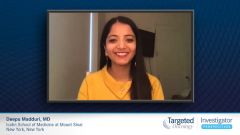
Favorable Safety Data from CARTITUDE-1
A review of the favorable safety data from CARTITUDE-1 for relapsed/refractory multiple myeloma.
Deepu Madduri, MD: The most common adverse event, grade 3 or higher, was hematological, as expected. We saw that the median time to recovery of grade 3 or 4 cytopenias was about 2 weeks for neutropenia and 4 weeks for thrombocytopenia. We did see some late recovery—greater than 1 month—of grade 3 or 4 cytopenia from first onset. Neutropenia was about 10%, and thrombocytopenia was about 26%.
One of the things that we always worry about with cytopenias is infections. We saw that any grade of infection was only 56% in these patients, with grade 3 or higher being 20%. The top infections seen in these patients undergoing CAR [chimeric antigen receptor] T-cell therapy was pneumonia, at 8%, and sepsis, at 4%.
Other common complications that we expect with CAR T-cell therapy are cytokine release syndrome [CRS] and neurotoxicity. Let’s talk a bit about cytokine release syndrome. All but 5 patients had cytokine release syndrome, and 95% reported having grade 1 or 2 CRS.
Another thing that I wanted to point out is the time of onset of CRS was 7 days, with 89% of patients having CRS at day 4 or later, and 74% of patients having it at day 6 or later. This is interesting, because this opens up the possibility of outpatient administration of cilta-cel [ciltacabtagene autoleucel].
Neurotoxicity is another common complication that we see with CAR T-cell therapies. We saw that total CAR T-cell neurotoxicity was 21%, with grade 3 or higher events occurring in about 10% of patients. Breaking this neurotoxicity down further, we saw 2 types: ICANS [immune effector cell-associated neurotoxicity syndrome] and other neurotoxicities. ICANS occurred in about 16 patients, mostly as grade 1 or 2 events, and all patients with ICANS had resolution of their symptoms. Other neurotoxicities occurred in about 12 patients, with symptoms ranging from movement and neurocognitive changes, to weakness, to personality disorders, to nerve palsy, to peripheral motor neuropathies. Six of these patients had resolution of their symptoms, and 6 did not. One patient had ongoing neurotoxicity. One died from complications of neurotoxicity. This patient actually went on hospice. Four patients died due to other causes, mostly due to sepsis or respiratory failure.
What’s interesting to point out is these ICANS and other neurotoxicity are not 16% and 12% together. Rather, a total of any grade was only 20%, with grade 3 or higher events occurring in 10% of patients. Another thing I want to point out is that we dosed an additional 50 patients—9 patients in the CARTITUDE-1 Japanese cohort and 41 patients in the CARTITUDE-2 and 4 developmental programs. We saw no additional movement and neurocognitive changes in these patients.
Transcript edited for clarity.











































